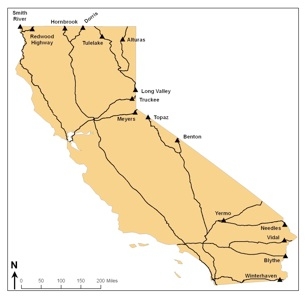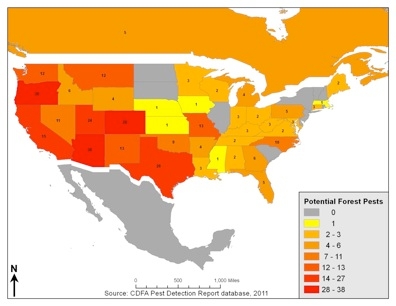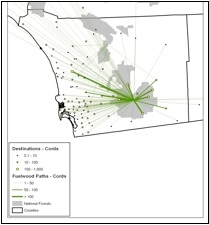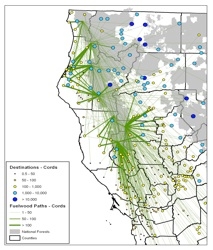Firewood movement is one way in which invasive plant pests and diseases can be transferred from one location to another, often resulting in devastation to natural resources. In an attempt to more effectively plan for and mitigate against potential threats to California’s urban and wildland forests, this document analyzes what is currently known about firewood movement into and within the State.
Known Risk
Roughly 99.8% of California’s land area is located within 50 miles of a State Park, National Park, or National Forest. Therefore, any introduced pest is a potential threat to the State’s outdoor recreation and natural conservation areas, as well as forest resources.
Entering California
California has 16 border stations along major highways that monitor vehicles coming into the State for unwanted pests associated with commodity products. In addition, there are 20 Homeland Security Custom Border Protection stations at international land, air, and seaports of entry, of which six service ports statewide handle commercial shipments and 14 handle individuals and their personal property.
Firewood Movement into California
With California being the 11th largest economy in the world (reference http://www.ccsce.com/PDF/Numbers-Jan-2012-CA-Economy-Rankings-2010.pdf), trade and travel continue to bring vast amounts of firewood into the State annually. In 2009, California received direct international shipments of firewood from Estonia, Honduras, Japan, Latvia, and Sweden. In 2010, more than 27.5 million private vehicles and 7 million commercial vehicles were inspected at California’s border protection stations (reference: http://www.cdfa.ca.gov/phpps/pe/ExteriorExclusion/borders.html).
This year, the USDA Forest Service, Region 5 performed an analysis of 2011 firewood-related Pest Detection Reports (PDR) generated by the California Department of Food and Agriculture (CDFA) regarding incoming firewood at the 16 State border stations to determine: 1) how much firewood is entering the state; 2) where the firewood is coming from and going to; 3) what forest pests have been intercepted on firewood entering the state, as well as the origin and destination of each load; and 4) what the potential threats are to California forests and parks from pests transported via firewood.
Firewood results for 2011
- Almost 23 million pounds (lbs) of firewood were recorded in 8,400 individual loads.
- Top entry points by weight were Hornbrook (8.8 million lbs), Redwood Highway (5.4 million lbs), Alturas (1.9 million lbs), and Yermo (1.7 million lbs).
- Nearly 63 percent of the firewood by weight was in commercial vehicles, but represented only 10 percent of the total number of individual loads.
- Firewood came to California from 46 other states, Canada, and Mexico. Top firewood origins by weight were Oregon (13 million lbs), California (2.9 million lbs), Canada (2.7 million lbs), and Utah (1.2 million lbs).
- Firewood was being taken to over 550 named destinations, the vast majority of which were in California (500 locations; 20 million lbs). Most of the rest was being taken to Reno, Nevada.
- Calculated as straight-line distances between border stations and named destinations, firewood in commercial vehicles was expected to travel twice as far on average then wood in private vehicles (193 miles versus 78).
- The average distance firewood was expected to travel varied widely between the border stations. Wood entering the state at Needles (268 miles), Hornbrook (192 miles), and Vidal (179 miles) traveled the furthest while wood entering at Winterhaven (8 miles) and Alturas (18 miles) tended to stay very local.


Potential Forest Pests Found in 2011
- Border stations intercepted 337 potential forest pests in firewood.
- Of the intercepted pests, 93 percent were beetles. No major United States invasive exotic pests were intercepted in 2011; however, in 2010, emerald ash borer was intercepted in firewood from Michigan.
- Potential forest pests came to California from 38 other states and Canada (Map 2). Top origins were Oregon (38 pests), Arizona (34 pests), Colorado (28 pests), and Texas (26 pests).
- Of the intercepted pests, 26 percent were in vehicles with California license plates, bringing wood back to California from at least 19 other states.
- Identified infested wood was being transported to 120 destinations, with major California cities and Yosemite National Park among the most common.
This initial analysis shows that movement of firewood across California’s borders may be an important pathway for invasive forest pests and diseases to enter the State, and highlights how border inspection stations are an important stopgap. However, firewood is still able to enter the state unchecked through entry points other than main border station locations and through state border stations during hours of non-operation. Additionally, the future of many border stations is uncertain given the current poor economic climate. Still needing examination for a full understanding of firewood movement into and within California are the international ports of entry.
Local Movement of Firewood in California
A USDA Forest Service, Region 5 analysis of Forest Service non-commercial firewood cutting permits issued for National Forests from 2000 to 2011 provide a cursory view of how locally cut wood for personal use is moved.
Map A and B show movement of permitted cut firewood off of three National Forests. The green lines track the origin of the cut wood back to the zip code logged for each permit given. Thicker lines indicate greater firewood movement to a given location. Both maps represent forests where invasive species have become established and are causing massive die-off of certain tree species. This may have implications for accidental movement of invasive species in San Diego County (goldspotted oak borer - Cleveland National Forest) and along the North Coast (sudden oak death - Mendocino and Six Rivers National Forests).

Regional Movement of Firewood in California
Yosemite National Park campground case study: In 2009, 10 campers in Yosemite were asked about their firewood habits when camping. Campers came from a variety of areas, including coastal California (70 percent), eastern California (10 percent), and out of state (10 percent).
Firewood: Ten percent of the campers brought wood from their own property, 10 percent purchased boxed wood within the park, and 20 percent brought in wood they had found at other camps. Forty percent planned to burn all of their wood onsite, 30 percent planned to take the remaining wood home, and 20 percent of campers planned to leave the unburned wood onsite.
Pests: Thirty percent of the campers were aware of State quarantines regarding firewood and pests; however, 10 percent brought banned host material anyway. While none of the campers had observed insect activity on their firewood, careful inspection by the ranger found that 40 percent of the wood inspected had visible insect galleries.
Statewide Movement of Firewood in California
An analysis of California’s commercial firewood importation, exportation, and movement within the State is underway. Larger commercial firewood dealers nationwide are moving toward a third-party certification program for firewood, with all wood kiln dried and meeting various standards of excellence that will be classified as gold, silver, and standard. More on the certification program and the American Firewood Producers and Distributors Association can be found at http://afpda.alreadysetup.com/.
